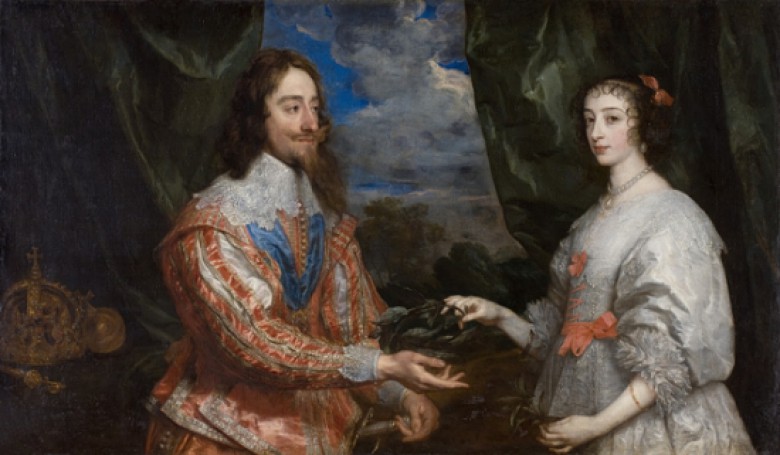1st May 2019
Today in 1625, Charles I and Henrietta Maria were married by proxy in Paris. Charles was twenty-four years old, and a king newly come to his throne after the death of his father, James I, a little over a month before. Henrietta Maria was a French princess, sister to King Louis XIII, and fifteen when she married Charles.
She was not the first choice of bride for Charles. His father James I had originally planned to use this marriage to create an allegiance with the powerful Hapsburg family. Charles’ sister, Elizabeth, had briefly been queen of Bohemia before her husband’s reign was ended by the Hapsburgs who wanted control of that region. She and her husband were forced into exile, and he lost his lands in the Palatinate. Elizabeth was seen as a Protestant heroine and English Protestants pushed James I to intervene. Realising a full-scale military intervention was too expensive to consider, James attempted a diplomatic solution – proposing that Charles would marry the Spanish princess, Maria Anna. This alliance was intended to pressure Maria Anna’s uncle – the Hapsburg Emperor Ferdinand II - to restore Elizabeth and Frederick to their thrones and give England a powerful ally.
However, negotiations for the marriage to the Infanta of Spain dragged on so long that Charles himself, accompanied by George Villiers, Duke of Buckingham, made an ill-fated journey to Spain in an attempt to win over Maria Anna in person. It proved to be unsuccessful but despite the fact that he returned home without a bride, there were celebrations in England, where the people wanted neither a Catholic nor a Spanish queen.
Charles and Buckingham were furious at their failure and determined to avenge their humiliation by making war on Spain. When his father King James refused to declare war, Charles and Buckingham pursued their plan and after James’ death in March 1625, they arranged an alternative marriage alliance with Spain’s long-standing enemy – France.
Charles had originally met the French princess Henrietta Maria when he visited the French court on his journey to Spain. Marriage to her would build a strong alliance with her brother King Louis XIII of France, provide access to his powerful army, and bring a generous dowry settlement. But Henrietta Maria was also a Catholic, and for that reason the marriage was unpopular in Protestant England.
The proxy wedding took place at Notre Dame Cathedral. Henrietta Maria was accompanied by her brother, Louis XIII, and followed by their mother, the formidable Marie de’ Medici. The proxy for Charles was the Duc de Chevreuse, who was a son of the Duke of Guise. Charles himself had distant links to the Guise family – his grandmother, Mary Queen of Scots, was daughter to Mary of Guise.
Despite being a Catholic himself, the Duc de Chevreuse, as Charles’s proxy, did not enter the Cathedral for the Catholic mass. He took up the role as proxy again when he lay side by side in bed with Henrietta Maria that night, each with one leg touching as a way to symbolise the consummation of the marriage.
After the wedding, Henrietta Maria left France for her new home in England, where she met her husband for only the second time. They wed again in person in June but despite her marriage to the king of England, Henrietta Maria would never be crowned queen. She remained a devout Catholic all her life, and the coronation service was a Protestant one. Instead, she watched her husband be crowned from a distance. It was another mark against the young queen, who remained unpopular for all of Charles’s reign.

Image: Portrait of Charles I and Queen Henrietta Maria, by Anthony van Dyck, 1632, Kroměříž Castle, via Wikimedia Commons.
